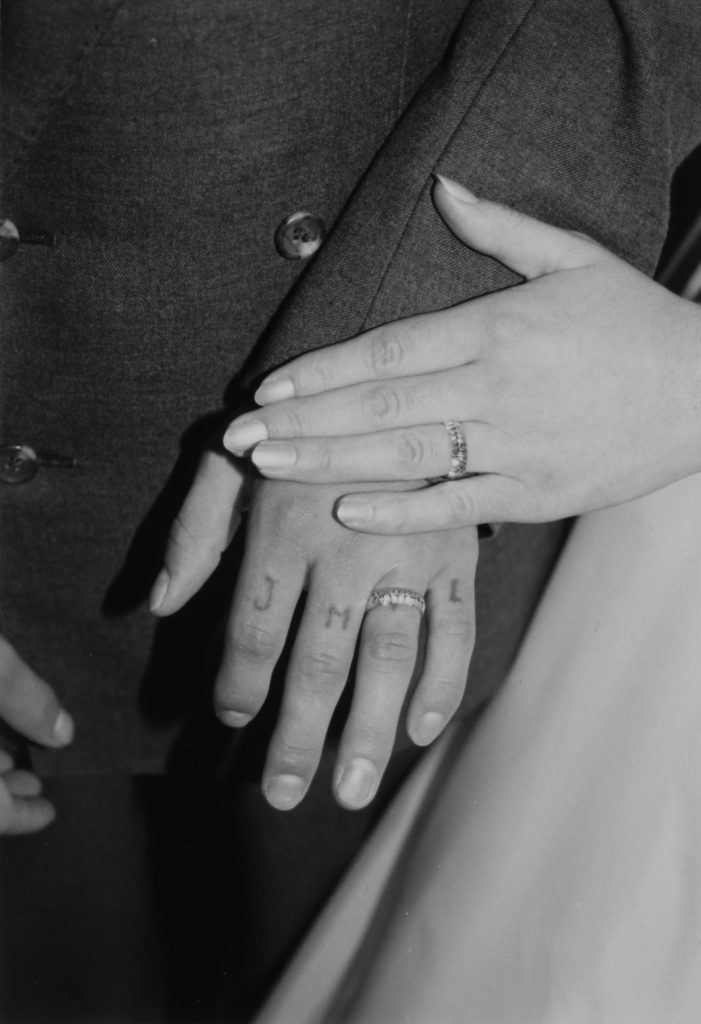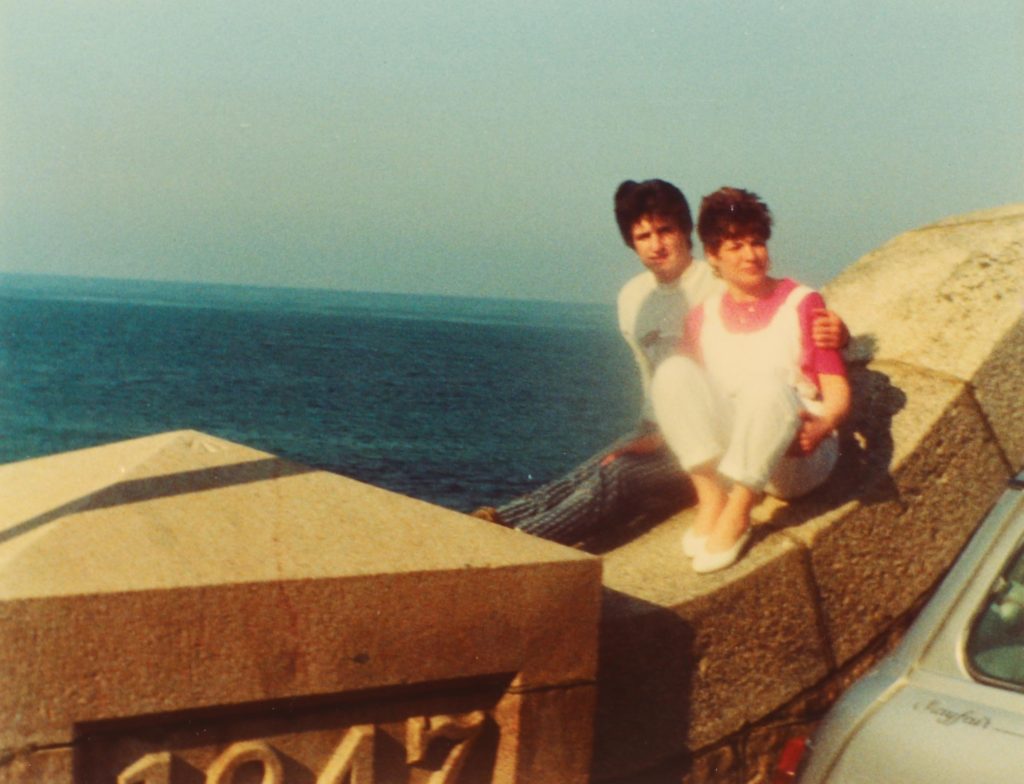Virtual version of my book: https://www.blurb.co.uk/books/10010414-a-family-story
All posts by Lucy L
Filters
Photo book design process
To create my photo book I will be using this blog post as a guide: https://hautlieucreative.co.uk/photo20al/2020/01/17/archival-images-establishing-a-timeline-narrative/
I will most likely begin my ordering my most effective archival images in chronological order beginning from when my parents were teenagers, to showing them meeting, through to marriage, having children and eventually separation. I may also include some montages I created in this too, if I feel it fits in with the rest of the selection to make the book flow easily.





2nd Layout:
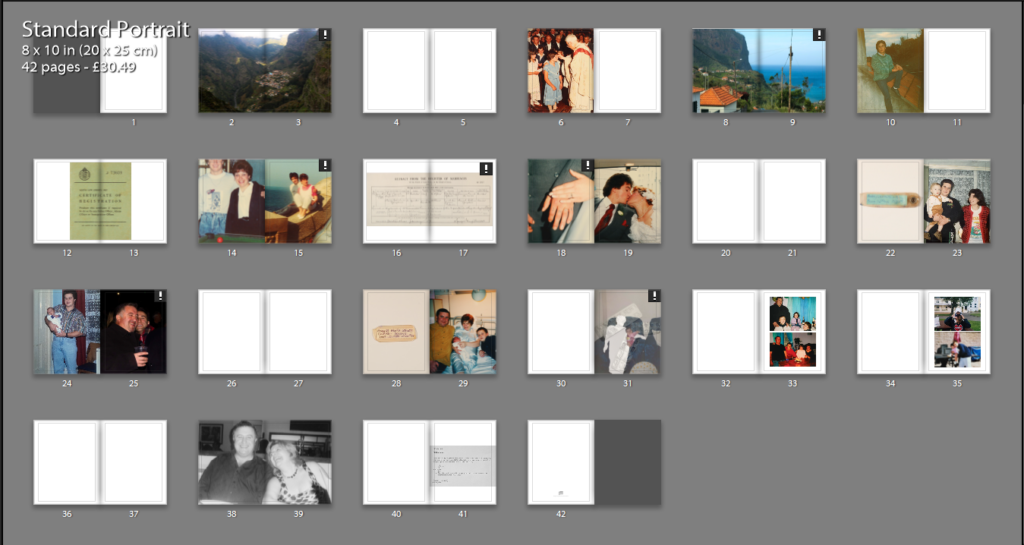
3rd layout:
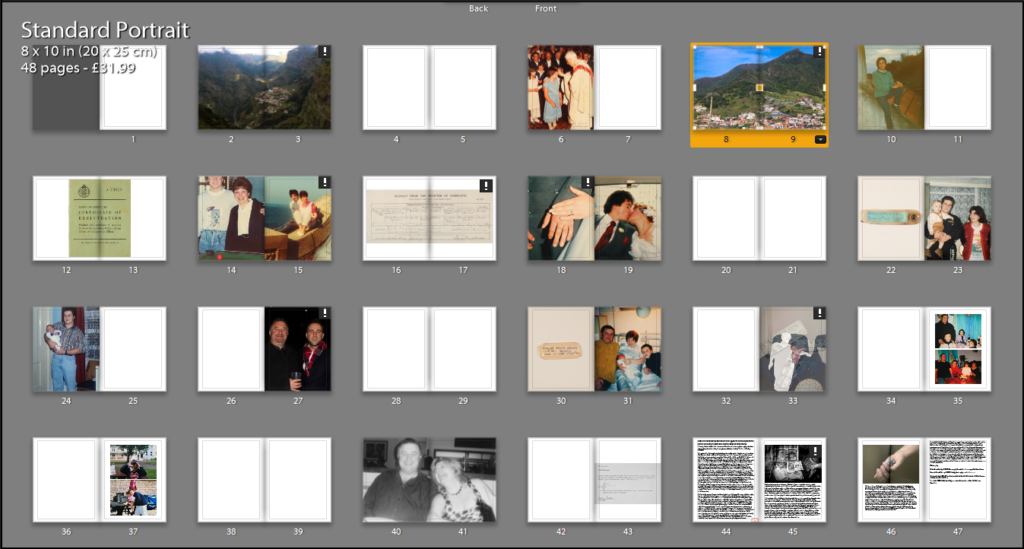

4th layout:

5th layout:

6th layout:

current Final layout:



The layout above is my current final layout. I plan on adding some quotes on some of the blank pages to add more context to images. I will also edit the image on 38-39 to further convey their separation.
Front/back cover:

Final essay draft
Final word count: 1,816
How do Diana Markosian and Rita Puig-Serra Costa express the notion of family history and relationships in their work?
“If manipulation is the first thing someone thinks of in connection to photography, what does that say about the value of the photograph as a reflection of reality?” (Bright and Van Erp 2019:17)
The notion of family is a subject that has been thoroughly explored by photographers such as Rita Puig-serra Costa and Diana Markosian. However, “when it comes to interpreting internal family dynamics, perspective is everything” (Hawarth,S. and Mclaney, S, 2016, 8). I believe each photographer portrays an either positive or negative view in regards to their personal relations, making it important to consider their individual point of view when deciding how much weight their narrative bears when showing the truth behind family dynamics. My personal study is focusing on my family’s history; more specifically the story of both my parents and important events in their life which lead to me being where I am today. I have chosen to analyse Markosian because her project “Inventing My Father” contrasts directly with Costa’s study “Where Mimosa Bloom” which I will also be referring to throughout this essay. I like the way Markosian explores the absence of her father in her life in such a personal and raw way, which eventually leads to a reunion which she captured through images. The photographs along with the context she provides into her life, makes this project very fascinating. Equally, I think the way Costa explores her family through the use of archival images and objects was effective as it really conveyed a sense of love and importance of family. I specifically loved how her entire project was an homage to her mother since carefully photographed objects paired with thoughtfully taken portraits further shows how fond she is of her family. These two photographers were particularly interesting to me as I felt I could personally relate to both bodies of work. Due to my Portuguese heritage, family is a of great importance to me and is valued highly in my family’s culture. However, my parents choosing to separate also led to the lack of a parental figure in my life which I will be exploring in the narrative. In this essay I will be discussing the notion of family and relationships, loss and hope in the works of both these artists, and evaluating my own response to their subjects.
Realism is the concept of capturing things in their natural element. This genre of photography is most useful when trying to capture something such as family history, as documentary photography allows us to be able to see someone’s real life situation through images. Photographers such as Dorothea Lange and Paul Strand focused on documenting the effects of urbanization and industrialization on working class Americans. This was something very prominent at the time of this movement, as the great depression in 1929 left a lot of people economically struggling. We now see this type of photography as realism. I feel as if this movement fits in well with my personal study as it recognizes the importance of capturing raw, documentary style images which I think is necessary when exploring something as personal as a family’s history, especially involving immigration and the struggle surrounding that journey. Images of this sort are characterized by having a wide depth of field and having sharp focus which contradicts the pictorialist style. The move away from creating a painterly aesthetic ultimately opened the door to a more forensic approach but also one that is open to distortion and manipulation in its pursuit of a good story of a good story. This will ultimately depend on the agenda of the artist, their integrity and skill in delivering a message, story or sequence of events.
In the words of Martin Parr, “most family albums are a form of propaganda, where the family looks perfect and everyone is smiling” (Hawarth, and Mclaney 2016, 7). Although to certain extent I believe this is true, Markosian goes against this idea as she uses a non-traditional method of exploring the family concept. Instead of portraying a sense of happiness and love, which is typically associated with family relationships, Markosian chooses a more raw and honest approach highlighting how she grew up without her father figure and turning that into the foundation that her project is built upon. In this context, I believe the words of John Tagg are appropriate as the view that “the camera is an instrument of evidence” (John Tagg:1988) perfectly demonstrates how Markosian’s work stands out amongst other artists exploring the same themes, since a certain truthfulness radiates from her images which goes against the dominating stereotype that every family is perfect, leading to a more contemporary output which appeals to modern day people.This view is put across quite skillfully and subtly through the use of black and white images which puts forward a sense of emptiness since the monochrome theme is often associated with despair. This means that the audience will be able to feel a certain coldness and the lack of emotion, while also simultaneously feeling a surge of emotion through the scenes and objects depicted in the images leading to an interesting contrast that is highly effective throughout her work. The use of archival imagery is complementary to Markosian’s photography since by itself it would usually portray a sense of happiness, however with the context, it is instead replaced with a slight sense of resentment, especially the archival image showing her dad cut out of an image.
I believe the image above to be one of Markosian’s best not just due to its impeccable technicality, but also because it is rich in context. This image shows a suitcase belonging to her father containing things such as undelivered letters, newspaper clippings, and a shirt he was saving for her brother’s wedding. This image is in black and white making it more emotionally detached yet since the objects are sentimental it creates an interesting juxtaposition, as it shows the photographer is conflicted over her feelings. I believe Diana Markosian represents a modern wave of photography where beauty can be found in imperfections, and appreciated.
“Where Mimosa Bloom” by Costa takes the completely opposite approach into the exploration of family culture. It becomes obvious that the entire project is very thoughtful and the audience can almost feel an overpowering sense of the love Costa has for her family. Although Costa focuses on the positiveness of relationships with family, I believe it is the underlying theme of her mother’s death which makes her work particularly stand out since it reinforces the view that “real families aren’t often idyllic” (Hawarth, and Mclaney, 2016, 7) , even though on the surface, her family circumstances appear favourable. While exploring important people, objects and places that play a significant role in her relationship with her mum, she alludes to her death in an ennobling way. This notion is put across carefully through many aspects throughout the book such as a light colour scheme which conveys a sense of delicacy through pastel shades and also the metaphorical link to mimosa, a tree that blooms bright, yellow flowers in Spring, in Barcelona, where Costa is from.
This image is one which perhaps evokes the most emotion. In this double page spread we see Costa clutching a premature bird in her hand. Costa said, “When she died, I felt like a bird whose mother had abandoned the nest. I had to learn how to fly on my own,”. The context in combination with the image depicts a real sense of vulnerability, conveyed through the bird, that Costa is feeling in relation to not having her mother anymore. I think that using the bird as a medium for her own feelings, further shows how much thought and care was taken into each image as this has deep metaphorical value. I think that Rita’s work is a more traditional way of portraying family as she utilises portraiture and archival objects in a positive way, while also showing feelings and emotions through metaphors. I believe Rita Puig-Serra’s work represents positive sentiments towards relationships giving an almost romantic representation of a typical family unit.This book exudes closeness and sentimentality, by showing a kind of poetic bond between her relatives. However, with the view that “photography is a system of visual editing” (John Szarkowski:1976), the possibility of work being refined and changed to reflect perfectionism could be high.
When capturing my own images, and throughout the editing process, I kept each photographer’s approach in mind. Below is a final outcomes of my personal study. You can see that by using Photoshop I was able to give the illusion that my mum was “cut out” of the image, and layered on top is an image showing medication used to manage her anxiety and depression. The aim of this picture is to show how my mother battled mental illness after my birth, while also representing the concept of family. This image contains elements from both Markosian and Costa’s work. The use of an archival image makes it very personal, expressing the sentiment of love, inspired by Costa’s work. However, the manipulation gives the image a certain degree truthfulness as it adds context about an emotionally difficult subject, and would otherwise may not have been obvious from the original image, similar to Markosian’s work.
To conclude, both Markosian and Costa have created very emotional pieces of work based on their own personal family stories and journeys. Although we do get a sense of love from Markosian’s work, I believe this sentiment is often fighting against a feeling of hatred and resentment towards her father, whereas we purely get the feeling of love and closeness from Costa’s photo book with hint of sadness due to the loss of her mother. Costa’s photo book contains a very unique color palette containing light, delicate, pastel colors which is expected as her images are delicately framed and excrete fondness towards her family. On the other hand, Markosian’s body of work contains a lot of black and white images which shows that there is a lot of distance between her and the subject, yet all the things she photographs are of rich sentimental meaning to her. Both photographers also make use of archival images and objects, Costa utilises this to show a deep connection to her mother whereas due to the nature of Markosian’s work, her archival objects are used to show her father as being someone she is detached from.
Bibliography:
Bright, S. and Van Erp, H.(2019). Photography Decoded. London: octopus Publishing House
Howarth, S. and McLaney, S. (2016). Family photography now. London: Thames & Hudson
Szarkowski, John (1976), William Eggleston’s Guide. New York & Cambridge, MA: The Museum of Modern Art & The MIT Press
Tagg, John (1988). The Burden of Representation. Basingstoke and New York: Palgrave Macmillan
Final prints/mounting
Here you will see my final prints, which I plan on mounting on foam board. I wanted to mount on foam board -instead of cutting a window mount for example- because my personal study is essentially a story. This means a foam board will be more suitable because it allows greater flow, and is not as strict and put in place as a window mount. Each image is going to represent a different point in the narrative, which I will explain below.

This archival image symbolises my parent’s marriage, and by making it black and white it also represents separation. This is because the filter represents how it is in the past. Since this is quite a large and important event it will be printed in A5.

original image 
final image


original image 
final image
Below are the selection of images I will be printing and mounting:
what my final piece will look like:

Actual final piece:

Photo montges
In this blog post I will be exploring the use of montages to express mental illness. I think montages may be the best way to convey this event because it’s something that is difficult to picture with a camera, but easier to show by manipulating and combining images. Below is a mood board with images I used as inspiration when creating my photo montages. In the images, most of the subjects are obscured from the images.

Images are not my own.
The image below I also used as a prime example, by my case study Diana Markosian.

Editing images:



first montage 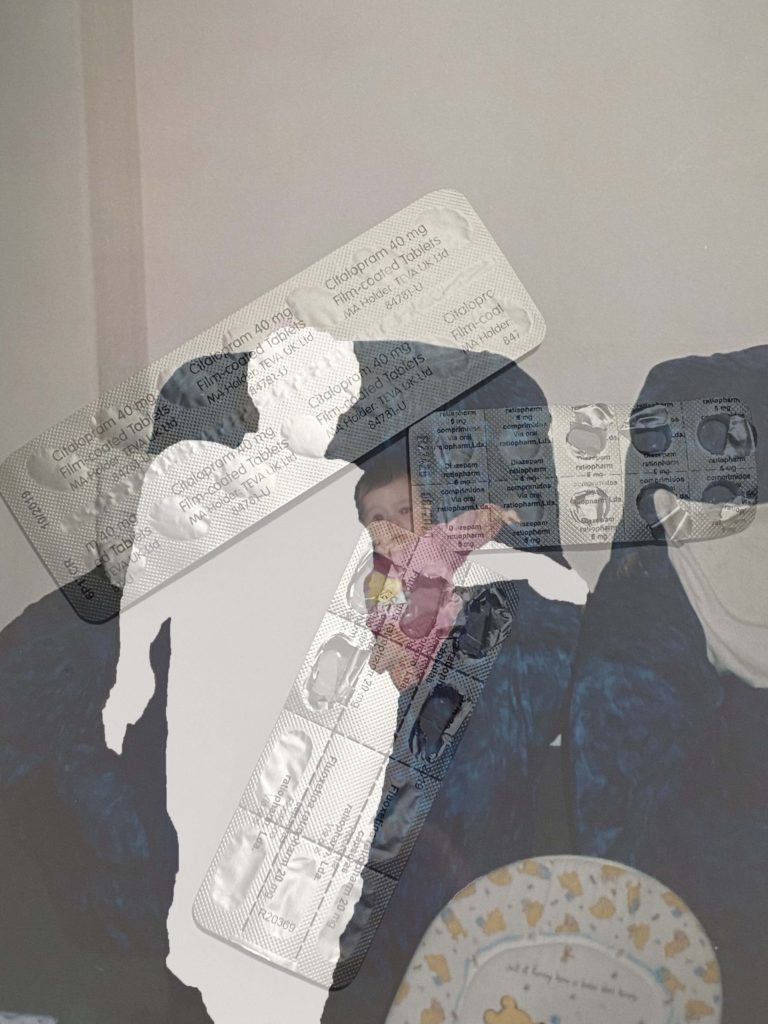
second montage
I began with an image of my mother, and me as a baby. I used the quick selection tool to select her, then right clicked pressing layer via cut, I then removed the layer, leaving a blank space in the image where my mother originally was. You can see the final output above. Although I thought it was a successful image I wanted to experiment with some variations. Because of this I added an image of her medication, and layered it over the top, and changed the opacity to around 50% so the original layer was visible. This is the 4th image you see above. I think overall both images are effective in conveying mental illness, however I think the second image gives more context to the situation. Ultimately, the image I will end up using will be the one that fits in more with the photo selection from my book, which I think will be the initial montage.

Similar to the process above I used the quick selection tool to obscure my mother from the image 
first montage 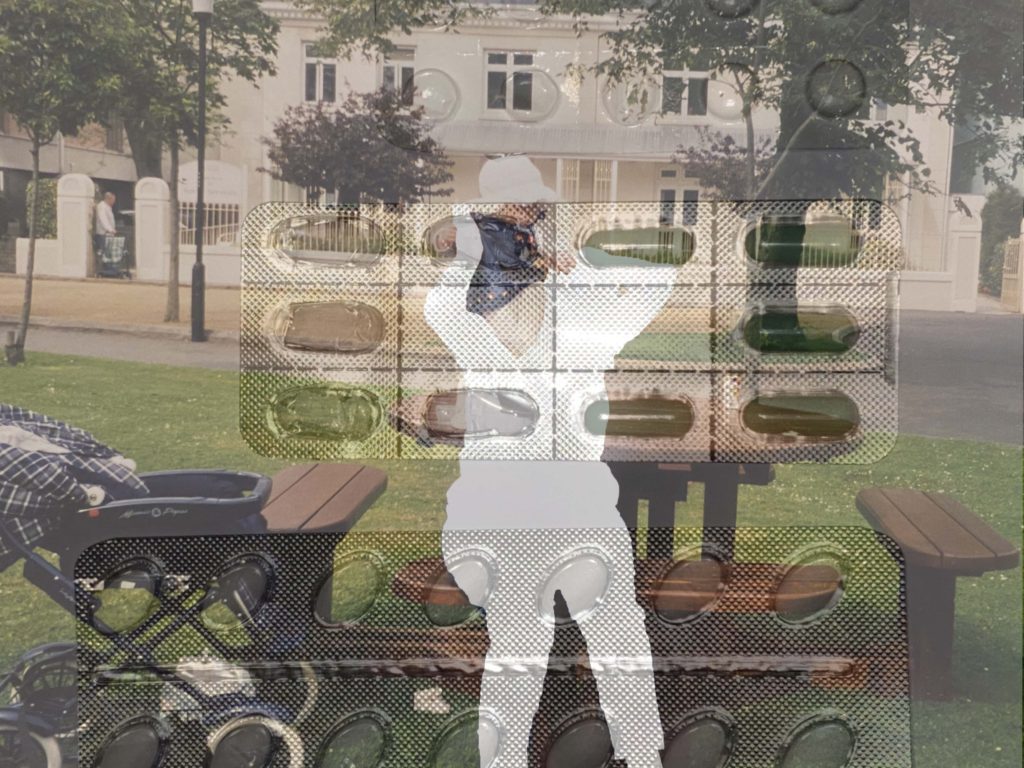
second montage
To complete the montages above I followed the same process stated at the beginning, the only difference being the image I layered on top of my archival image.
4th essay draft
How do Diana Markosian and Rita Puig-Serra Costa express the notion of family history and relationships in their work?
“If manipulation is the first thing someone thinks of in connection to photography, what does that say about the value of the photograph as a reflection of reality?” (Bright and Van Erp 2019:17)
The notion of family is a subject that has been thoroughly explored by photographers such as Rita Puig-serra Costa and Diana Markosian. However, “when it comes to interpreting internal family dynamics, perspective is everything” (Hawarth,S. and Mclaney, S, 2016, 8). I believe each photographer portrays an either positive or negative view in regards to their personal relations, making it important to consider their point of view when deciding how much weight their narrative bears when showing the truth behind family dynamics. My personal study is focused on my family’s history; more specifically the story of both my parents and important events in their life which lead to me being where I am today. I have chosen to analyze Markosian because her project “Inventing My Father” contrasts directly with Costa’s study “Where Mimosa Bloom” which I will also be referring to throughout this essay. I like the way Markosian explores the absence of her father in her life in such a personal and raw way, which eventually leads to a reunion which she captured through images. The photographs along with the context she provides into her life, makes this project very interesting. Equally, I think the way Costa explores her family through the use of archival images and objects was effective as it really conveyed a sense of love and importance of family. I specifically loved how her entire project was an homage to her mother since carefully photographed objects paired with thoughtfully taken portraits further shows how fond she is of her family. These two photographers were particularly interesting to me as I felt I could personally relate to both bodies of work. Due to my portuguese heritage, family is a of great importance to me and is valued highly in my family’s culture. However, my parents choosing to separate also led to the lack of a parental figure in my life which will be included in the narrative I intend to tell. In this essay I will be discussing the notion of family and relationships, loss and hope in the works of both these artists.
Realism is the concept of capturing things in their natural element. This genre of photography is most useful when trying to capture something such as family history, as documentary photography allows us to be able to see someone’s real life situation through a photograph. Photographers such as Dorothea Lange and Paul Strand focused on documenting the effects of urbanization and industrialization on working class Americans. This was something very prominent at the time of this movement, as the great depression in 1929 left a lot of people struggling. We now see this type of photography as realism. I feel as if this movement fits in well with my personal study as it recognizes the importance of capturing raw, documentary style images which I think is necessary when exploring something as personal as a family’s history, especially involving immigration and the struggle surrounding that journey. Images of this sort are characterized by having a wide depth of field and having sharp focus which contradicts the pictorialist style. The move away from creating a painterly aesthetic ultimately opened the door to a more forensic approach but also one that is open to distortion, manipulation and the notion of narrative. This will ultimately depend on the agenda of the artist, their integrity and skill in delivering a message, story or sequence of events.
In the words of Martin Parr, “most family albums are a form of propaganda, where the family looks perfect and everyone is smiling” (Hawarth, s and Mclaney 2016, 7). Although to certain extent I believe this is true, Markosian goes against this idea as she uses a non-traditional method of exploring the family concept. Instead of portraying a sense of happiness and love, which is typically associated with family relationships, Markosian chooses a more raw and honest approach highlighting how she grew up without her father figure and turning that into the foundation that her project is built upon. In this context, I believe the words of John Tagg are appropriate as the view that “the camera is an instrument of evidence” (John Tagg:1988) perfectly demonstrates how Markosian’s work stands out amongst other artists exploring the same themes, since a certain truthfulness radiates from her images which goes against the dominating stereotype that every family is perfect, leading to a more contemporary output which appeals to modern day people.This view is put across quite skillfully and subtly through the use of black and white images which puts forward a sense of emptiness since the monotone theme is often associated with despair. This means that the audience will be able to feel a certain coldness and the lack of emotion, while also simultaneously feeling a surge of emotion through the scenes and objects depicted in the images leading to an interesting contrast that is highly effective throughout her work. The use of archival imagery is complementary to Markosian’s photography since by itself it would usually portray a sense of happiness, however with the context, it is instead replaced with a slight sense of resentment, especially the archival image showing her dad cut out of an image.
I believe the image above to be one of Markosian’s best not just due to its impeccable technicality, but also because it is rich in context. This image shows a suitcase belonging to her father containing things such as undelivered letters, newspaper clippings, and a shirt he was saving for her brother’s wedding. This image is in black and white making it more emotionally detached yet since the objects are sentimental it creates an interesting juxtaposition, as it shows the photographer is conflicted over her feelings.I believe Diana Markosian represents a modern wave of photography where beauty can be found in imperfections, and appreciated.
“where mimosa bloom” by Costa takes the completely opposite approach into the exploration of family culture. It becomes obvious that the entire project is very thoughtful and the audience can almost feel an overpowering sense of the love Costa has for her family. Although Costa focuses on the positiveness of relationships with family, I believe it is the underlying theme of her mother’s death which makes her work particularly stand out since it reinforces the view that “real families aren’t often idyllic” (Hawarth,S. and Mclaney, S, 2016, 7) , even though on the surface, her family circumstances appear favourable. While exploring important people, objects and places that play a significant role in her relationship with her mum, she alludes to her death in an ennobling way. This notion is put across carefully through many aspects throughout the book such as a light colour scheme which conveys a sense of delicacy through pastel shades and also the metaphorical link to mimosa, a tree that blooms bright, yellow flowers in Spring, in Barcelona, where Costa is from.
This image is one which perhaps conducts the most emotion. In this double page spread we see Costa clutching a premature bird in her hand. Costa said, “When she died, I felt like a bird whose mother had abandoned the nest. I had to learn how to fly on my own,”. The context in combination with the image depicts a real sense of vulnerability, conveyed through the bird, that Costa is feeling in relation to not having her mother anymore. I think that using the bird as a medium for her own feelings, further shows how much thought and care was taken into each image as this has deep metaphorical value. I think that Rita’s work is a more traditional way of portraying family as she utilises portraiture and archival objects in a positive way, while also showing feelings and emotions through metaphors. I believe Rita Puig-Serra’s work represents positive sentiments towards relationships giving an almost romantic representation of a typical family unit.This book exudes closeness and sentimentality, by showing a kind of poetic bond between her relatives. However, with the view that “photography is a system of visual editing” (John Szarkowski:1976), the possibility of work being refined and changed to reflect perfectionism could be high.
To conclude, both Markosian and Costa have created very emotional pieces of work based on their own personal family stories and journeys. Although we do get a sense of love from Markosian’s work, I believe this sentiment is often fighting against a feeling of hatred and resentment towards her father, whereas we purely get the feeling of love and closeness from Costa’s photo book with hint of sadness due to the loss of her mother. Costa’s photo book contains a very unique color palette containing light, delicate, pastel colors which is expected as her images are delicately framed and excrete fondness towards her family. On the other hand, Markosian’s body of work contains a lot of black and white images which shows that there is a lot of distance between her and the subject, yet all the things she photographs are of rich sentimental meaning to her. Both photographers also make use of archival images and objects, Costa utilises this to show a deep connection to her mother whereas due to the nature of Markosian’s work, her archival objects are used to show her father as being someone she is detached from.
Bibliography:
Bright, S. and Van Erp, H.(2019). Photography Decoded. London: octopus Publishing House
Howarth, S. and McLaney, S. (2016). Family photography now. London: …….
Szarkowski, John (1976), William Eggleston’s Guide. New York & Cambridge, MA: The Museum of Modern Art & The MIT Press
Tagg, John (1988). The Burden of Representation. Basingstoke and New York: Palgrave Macmillan
3rd essay draft
How do Diana Markosian and Rita Puig-Serra Costa express the notion of family history and relationships in their work?
"If manipulation is the first thing someone thinks of in connection to photography, what does that say about the value of the photograph as a reflection of reality?" (Bright and Van Erp 2019:17)
The notion of family is a subject that has been thoroughly explored by photographers such as Rita Puig-serra Costa and Diana Markosian. My personal study is focused on my family's history; more specifically the story of both my parents and important events in their life which lead to me being where I am today. I have chosen to analyze Markosian because her project "Inventing My Father" contrasts directly with Costa's study "Where Mimosa Bloom" which I will also be referring to throughout this essay. I like the way Markosian explores the absence of her father in her life in such a personal and raw way. In her project she explores the absence of her father, which eventually leads to a reunion which she captured through images. The photographs along with the context she provides into her life, makes this project very interesting. Equally, I think the way Costa explores her family through the use of archival images and objects was very effective as it really conveyed a sense of love and importance of family.I specifically loved how her entire project was an homage to her mother as it further shows how fond she is of her family when paired with carefully photographed objects, a thoughtfully taken portraits. These two photographers were particularly interesting to me as I felt I could personally relate to both bodies of work. Due to my portuguese heritage, family is a of great importance to me and is valued highly in my family’s culture. However, my parents choosing to separate also led to the lack of a parental figure in my life which will be included in the narrative I intend to tell. In this essay I will be discussing the notion of family and relationships, loss and hope in the works of both these artists.
Realism is the concept of capturing things in their natural element. This genre of photography is most useful when trying to capture something such as family history, as documentary photography allows us to be able to see someone's real life situation through a photograph. Photographers such as Dorothea Lange and Paul Strand focused on documenting the effects of urbanization and industrialization on working class Americans. This was something very prominent at the time of this movement, as the great depression in 1929 left a lot of people struggling. We now see this type of photography as realism. I feel as if this movement fits in well with my personal study as it recognizes the importance of capturing raw, documentary style images which I think is important when exploring something as personal as a family’s history, especially when it involves immigration and the struggle surrounding that journey. Images of this sort are characterized by having a wide depth of field and having sharp focus which contradicts the pictorialist style. The movement away from creating a painterly aesthetic ultimately opened the door to a more forensic approach but also one that is open to distortion, manipulation and the notion of narrative. This will ultimately depend on the agenda of the artist, their integrity and skill in delivering a message, story or sequence of events.
Markosian’s “personal exploration” (Fiona Mackdonald 2019) can be seen as a non-traditional method of exploring the family concept. Instead of portraying a sense of happiness and love, which is typically associated with family relationships, Markosian chooses a more raw and honest approach highlighting how she grew up without her father figure and turning that into the foundation that her project is built upon. I believe this makes her work stand out amongst other artists exploring this same theme, since “the camera is an instrument of evidence” (John Tagg:1988) a certain truthfulness radiates from her images which goes against the dominating stereotype that every family is perfect, leading to more contemporary outputs that appeal to modern day people. This view is put across quite skillfully and subtly through the use of black and white images which puts forward a sense of emptiness since the monotone theme is often associated with despair. This means that the audience will be able to feel a sense of coldness and the lack of emotion, while also simultaneously feeling a surge of emotion through the scenes and objects depicted in the images leading to an interesting contrast that is highly effective throughout her work. The use of archival imagery is complementary to Markosian’s photography since by itself it would usually portray a sense of happiness, however with the context, it is instead replaced with a slight sense of resentment, especially the archival image showing her dad cut out
I believe the image above to be one of Markosian's best not just due to its impeccable technicality, but also because it is rich in context. This image shows a suitcase belonging to her father containing things such as undelivered letters, newspaper clippings, and a shirt he was saving for her brother’s wedding. This image is in black and white making it more emotionally detached yet since the objects are sentimental it creates an interesting juxtaposition, as it shows the photographer is conflicted over her feelings.I believe Diana Markosian represents a modern wave of photography where beauty can be found in imperfections, and still appreciated.
“where mimosa bloom” by Costa takes the completely opposite approach into the exploration of family culture. It becomes obvious that the entire project is very thoughtful and the audience can almost feel an overpowering sense of the love Costa has for her family. Although Costa focuses on the positiveness of relationships with family, I believe it is the underlying theme of her mother’s death which makes her work particularly stand out as she alludes to it in a respectful way, while also exploring important people, objects and places that play a significant role in her relationship with her mum making her work more original. This notion is put across carefully through many aspects such as a light colour scheme throughout the book conveying a sense of delicacy through pastel shades and also the metaphorical link to mimosa, a tree that blooms bright, yellow flowers in Spring, in Barcelona, where Costa is from.
This image is one which perhaps conducts the most emotion. In this double page spread we see Costa clutching a premature bird in her hand. Costa said, “When she died, I felt like a bird whose mother had abandoned the nest. I had to learn how to fly on my own,”. The context in combination with the image show a real sense of vulnerability, shown through the bird, that Costa is feeling in relation to not having her mother anymore. I think that using the bird as a medium for her own feelings, further shows how much thought and care was taken into each image as this has deep metaphorical value. I think that Rita's work is a more traditional way of portraying family as she utilises portraiture and archival objects in a positive way. I believe Rita Puig-Serra's work represents positive sentiments towards relationships giving a romantic representation of a typical family unit.This book exudes closeness and sentimentality, a kind of poetic bond between her relatives. However, it has been said “photography is a system of visual editing” (John Szarkowski:1976), which suggests that some work may be refined and tailored in order to portray perfectionism.
To conclude, both Markosian and Costa have created very emotional pieces of work based on their own personal family stories and journeys. Although we do get a sense of love from Markosian's work, I believe this sentiment is often fighting against a feeling of hatred and resentment towards her father, whereas we purely get the feeling of love and closeness from Costa's photo book with hint of sadness due to the loss of her mother. Costa's photo book contains a very unique color palette containing light, delicate, pastel colors which is expected as her images are delicately framed and excrete fondness towards her family. On the other hand, Markosian's body of work contains a lot of black and white images which shows that there is a lot of distance between her and the subject, yet all the things she photographs are of rich sentimental meaning to her. Both photographers also make use of archival images and objects, Costa utilises this to show a deep connection to her mother whereas due to the nature of Markosian's work, her archival objects are used to show her father as being someone she is detached from.
Bibliography:
Bright, S. and Van Erp, H.(2019). Photography Decoded. London: octopus Publishing House
Mackdonald, Fiona (2019).“Diana Markosian: A father cut out of a family album”. BBC culture
Szarkowski, John (1976), William Eggleston’s Guide. New York & Cambridge, MA: The Museum of Modern Art & The MIT Press
Tagg, John (1988). The Burden of Representation. Basingstoke and New York: Palgrave Macmillan
book specification
Narrative:What is your story?
Describe in:
- 3 words: A family story
- A sentence: A personal family narrative.
- A paragraph: Through the use of archival imagery and objects, along with a few landscapes, I intend on telling my family’s story, beginning with the fact that both my parents migrated to Jersey, to eventually marrying, having children, and separating.
Design: Consider the following
- How you want your book to look and feel: since my book with be a personal story told through images I’d like mt book to have “photo album” feel and look as much as possible. Maybe through something such as a textured front and back cover, and through the look of the front and back.
- Paper and ink:
- Format, size and orientation: My book will have a mixture of landscape and portrait images, and for this reason I think the book would look best in a square format (12″x12″ / 7″x7″)
- Binding and cover: Ideally I think a textured Cover would be best to fit in with my concept, or maybe a dust jacket so that I could include come contextual information on the inside of the book without compromising the design of the actual book.
- Title: I am exactly sure on my title yet, however I want it to reflect the theme of family and relationships. I think it would be more effective if I made the title link in with something that directly related to my personal family story like Costa did with her metaphorical link to Mimosa in her title, “where mimosa bloom”.
- Editing and sequencing: At the moment, the sequencing of my book and images will be in chronological order, however I may include some parallels with archival images and current day images in order to give the book a more emotional sentiment.
- Images and text: I want to include minimal text in my book, As I want the sequencing of the images to tell the story. I may include things such as a small title, and perhaps the date under images if I feel they need to be explained, as seen in some photo albums, however it will be quite small in order to not distract from the images.
Personal study: Madeiran landscapes
Plan:
In order to add more context to my personal study I wanted to make sure to capture landscapes on the island my parents are originally from. While on holiday, I will be taking images in both villages that my parents are from as I think my photobook would benefit from having a few landscapes, to separate the portraiture, and archival images. I want to take images at different points of the day, and the weather will most likely vary slightly meaning I will be using different camera settings depending on what the scene is like.
Lightroom selection:

Editing my best images:

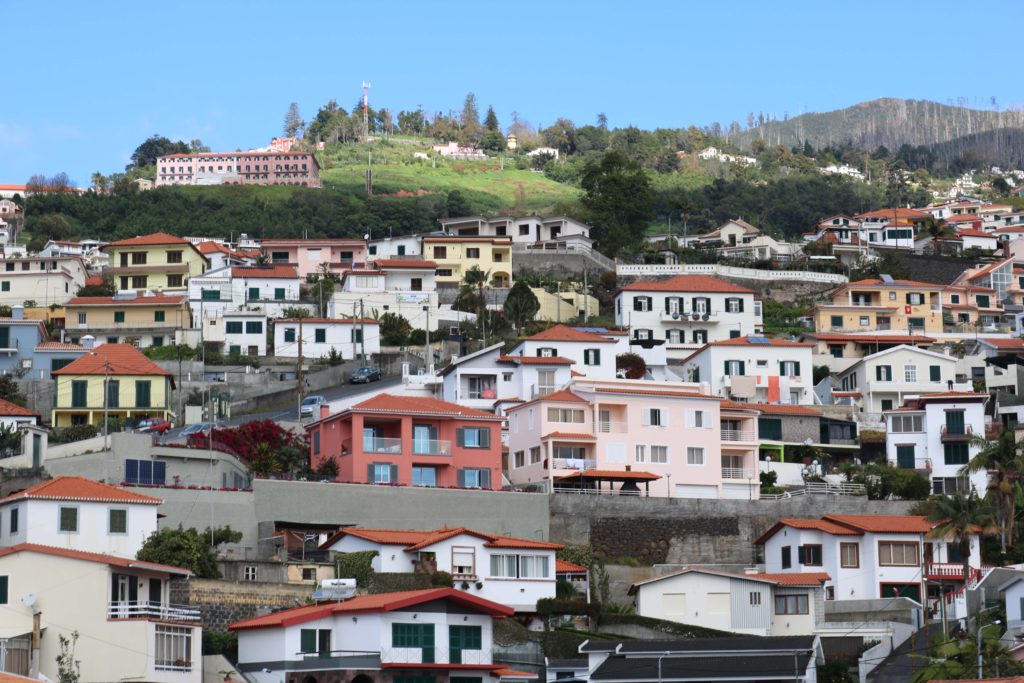
Before 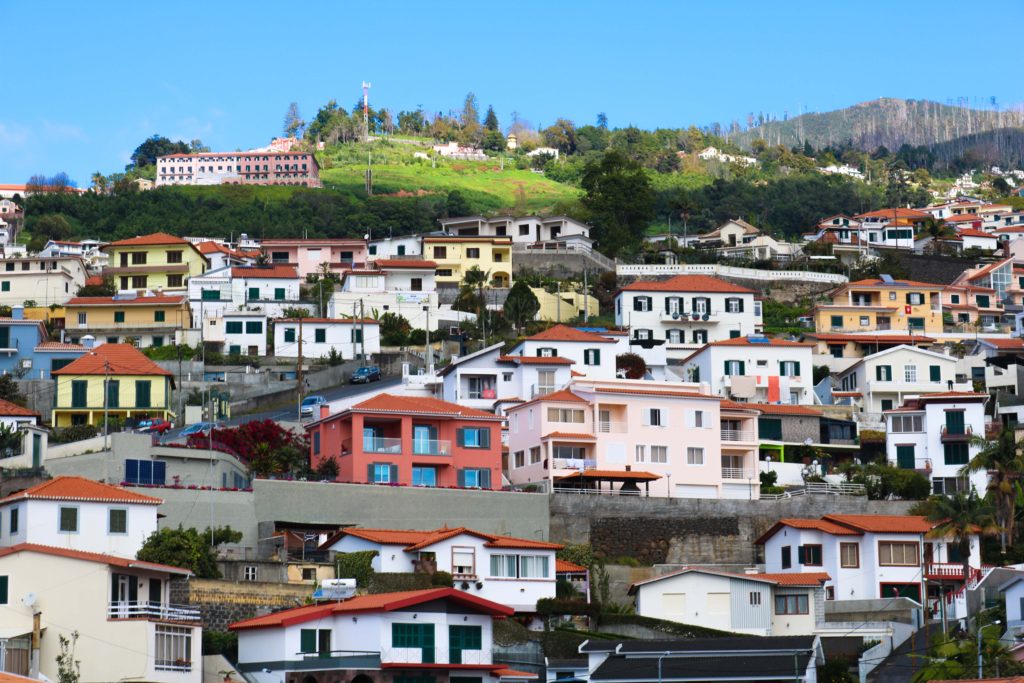
After
This image was taken just as I was driving out of the airport into the main city, and has no particular symbolic role. I chose this image as one of my best, because I like how to looks messy, yet very aesthetically pleasing at the same time. On one hand, there is nothing particular organised about the photo, however I think that all the bright colours help the image look quite appealing, and helps draw in attention.
These next few images were taken while I was visiting my dad’s hometown, Porto da Cruz. It is a fairly small municipality with a population of around 2,000 people located at the north-eastern part of the island.


Before 
After


Before 
After


Before 
After
These last images show Curral Das Freiras, where my mother and her family is from. This is a little secluded village in the heart of the island with a population of around 2,000 people. named Valley of the nuns as it was a refuge to 16th century nuns during times where pirates frequently attacked the island. As you’ll be able to see from the images below, the village is surrounded by cliffs and peaks making it quite secluded from other areas of the island. These images were all taken from a particular viewpoint, Eira Do Serrado, which stands at an elevation of 1.096m allowing the entire village to be seen.

This image is perhaps my favourite from my outcomes as were able to see the skyline, mountains and village all in one making a successful landscape. Due to the fog at the top of the mountains, My image was slightly overexposed leading my image to have a whiteish tint to it. After adapting the contrast and exposure, I believe I found the right balance and by changing the vibrancy I was able to restore some colour to the scene making it appear more inviting, and less dull.

Before 
After


Before 
After


Before 
After
Evaluation:
I think overall I was able to capture a few successful images depicting both important parts of the island. However, I think I should have experimented more by photographing a few more different areas as most of my images are taken from the same places.
Personal study: Portraits
Plan:
For this photoshoot I wanted to capture images showing my father, my brother, and my brother’s family. I’m planning on taking these images at a bonfire event we will be attending. I think this will be interesting as it will allow me to get some more “natural” looking images since, for the most part, I will not be telling the subjects how to pose allowing me to capture more candid looking outputs. Since it will be dark, I will have to use flash when talking all these images, along with a quick shutter speed as I will be moving around a lot. My aim is to show close bonds between the family members.
Selecting images on Lightroom:


Editing my best images:
When editing the below images, I followed very similar steps in order to make sure these images had a more uniform look. I wanted to make sure my subjects stood out amongst the background since we were in public and there was a lot of distraction, and it was important they were the main focal point of my image as my aim was to show a close bond between everyone. I increased the contrast and decreased the exposure the appropriate amount for each image. In combination with this, I also increased the vibrancy to reintroduced some colour into the image, after the exposure was decreased.


Before 
After
pictured above (left to right) is my father and brother.


Before 
After


Before 
After
Pictured above: My brother, his girlfriend and her daughter
Evaluating the shoot:
On the whole, I feel that I was able to capture some technically successful images using my camera, and flash. I think I was able to show key members of my family and also the concept of family. On the other hand, I think that I may struggle to make these images fit in with my photo book narrative because These images are taken at an event, not portraits.



